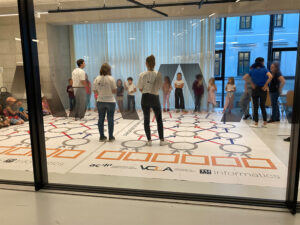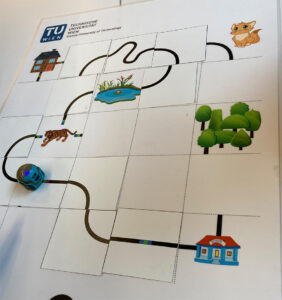European Researchers Night: School Workshops
On September 29, the Vienna Center for Logic and Algorithms (VCLA) together with TU Wien Informatics eduLAB held workshops on computer science for elementary school children at the University of Applied Arts Vienna as part of the European Researchers Night.
The workshops started with a discussion of the words informatics and algorithms. The instructor would ask if the children had heard these words before, and most children replied that they had not (except for their teachers mentioning the topic of the workshop in the morning). The children learned that an algorithm was basically a set of instructions or rules that had to be followed, and that such rules could also take the form of something as simple as a morning greeting routine.
 |
Subsequently, the children were introduced to the VCLA sorting networks. The sorting network works in the following way: Every participant steps on one of the orange squares (the input nodes) and receives a card with a random number on it. They then go on to the nearest sorting node (the gray circles in the picture) and compare numbers with the other person who steps on it. The person with the lower number follows the blue line, while the person with the higher number follows the red line. This process is then repeated until everyone arrives at another orange square (the output node). In this way, all the numbers will be sorted correctly in ascending order, and this works with letters (or other input) as well! At the workshops, the activity was carried out with numbers and animals of different size which were only visible under ultraviolet light (we used special pens for this). |
 |
The second activity consisted of slightly sticky tiles that had to be placed onto a sheet of paper. The tiles had black lines on them, and the children were asked to lay them on a map that depicted a house, a school building, a cat, a tiger, a pond, and a small wood. Essentially, the children needed to find their way home from school, and there was more than one possible solution. Once the tiles had been laid, the instructor placed the line-following robot Ozobot onto the map, and the robot followed the trail that the children had prepared. Some tiles contained a color code that either made the robot accelerate or made it turn in circles, almost like a dance. All we heard was:
“This is so cool!” Everyone had fun in finding swifter routes, or in trying out what the robot would do if it was led to the tiger or the pond. |
We hope we could help spark some interest in informatics in the young generation! TU Wien Informatics eduLAB is offering similar workshops at the Faculty of Informatics until end of January 2024.
